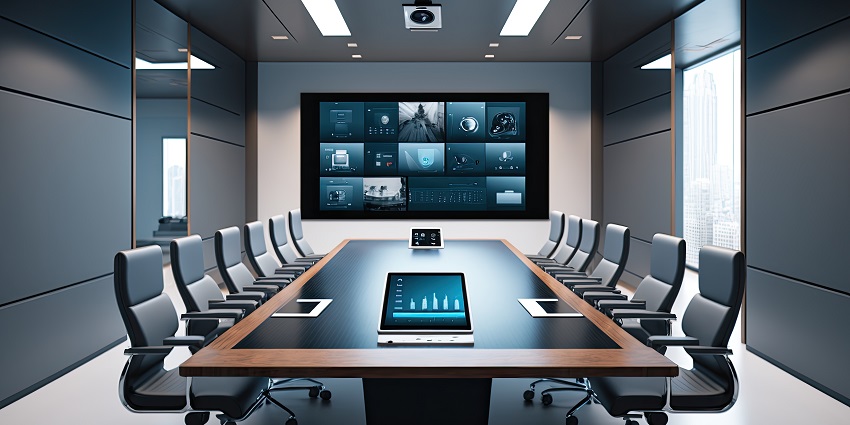views

Introduction:
In today's fast-paced business environment, conference rooms serve as vital hubs for collaboration, decision-making, and innovation. To optimize productivity and streamline operations, many organizations are turning to automation solutions for their conference rooms. However, with a myriad of options available, selecting the right automation solution can be daunting. In this guide, we'll explore the top trendy questions and concerns people have when choosing solutions for conference room automation and provide key considerations to help you make an informed decision.
1. How can automation improve conference room efficiency?
Automation solutions offer numerous benefits for conference rooms, including:
- Streamlining Meeting Setup: Automation can automate tasks such as powering on equipment, adjusting lighting and temperature, and configuring audiovisual settings, saving time and ensuring a seamless meeting experience.
- Enhancing User Experience: Intuitive interfaces and user-friendly controls enable participants to easily start meetings, share content, and collaborate effectively, increasing engagement and productivity.
- Optimizing Resource Allocation: Automation systems can monitor room usage and occupancy, enabling organizations to optimize space utilization, allocate resources efficiently, and reduce costs.
- Integrating with Collaboration Tools: Automation solutions can integrate with popular collaboration platforms such as Zoom, Microsoft Teams, and Google Meet, enabling seamless integration of video conferencing, screen sharing, and document collaboration tools.

2. What are the key features to look for in a conference room automation solution?
When evaluating conference room automation solutions, consider the following key features:
- Centralized Control: Look for solutions that offer centralized control and management of all conference room devices and systems, allowing administrators to monitor and control room settings remotely.
- Compatibility: Ensure compatibility with existing hardware and software infrastructure, including AV equipment, displays, projectors, video conferencing systems, and collaboration tools.
- Scalability: Choose a scalable solution that can accommodate future growth and expansion, allowing you to easily add or upgrade conference room features and functionalities as needed.
- Customization Options: Seek solutions that offer flexibility and customization options to tailor the automation system to meet your organization's specific requirements and preferences.
- Security: Prioritize security features such as user authentication, encryption, and access controls to safeguard sensitive information and prevent unauthorized access to conference room resources.
- Integration Capabilities: Select a solution with robust integration capabilities that can seamlessly integrate with third-party applications, systems, and services to enhance functionality and interoperability.
- User Interface: Consider the ease of use and intuitiveness of the automation system's user interface, ensuring that users can navigate and control room settings effortlessly without extensive training or technical expertise.
3. How can automation solutions enhance the meeting experience?
Automation solutions can enhance the meeting experience in several ways:
- Simplified Meeting Start: With automation, starting meetings is as simple as pressing a button or tapping a screen, eliminating the need for manual setup and configuration.
- Seamless Connectivity: Automation systems can automatically connect to video conferencing platforms, wireless presentation systems, and collaboration tools, enabling seamless integration and communication.
- Enhanced Collaboration: Intuitive interfaces and interactive displays facilitate real-time collaboration, allowing participants to share content, annotate documents, and engage in interactive discussions effortlessly.
- Customizable Room Settings: Automation solutions enable users to customize room settings such as lighting, temperature, and audio levels to create a comfortable and productive meeting environment.
- Time-Saving Features: Automation can automate routine tasks such as scheduling meetings, sending reminders, and generating meeting reports, freeing up time for more meaningful and productive interactions.

4. What are the cost considerations associated with conference room automation?
When budgeting for conference room automation, consider the following cost factors:
- Initial Investment: The cost of hardware, software licenses, installation, and setup can vary depending on the size and complexity of the automation system.
- Ongoing Maintenance: Factor in the cost of ongoing maintenance, updates, and support services to ensure the reliability and performance of the automation solution over time.
- Integration Costs: Integration with existing infrastructure, AV equipment, and collaboration platforms may require additional investment in compatibility testing, configuration, and customization.
- Training and Support: Budget for training sessions and technical support to ensure that users are proficient in operating the automation system and troubleshooting any issues that may arise.
- Return on Investment (ROI): Evaluate the potential ROI of conference room automation in terms of productivity gains, cost savings, and improved collaboration and decision-making processes.
Conclusion:
Choosing the Houston conference room automation solution requires careful consideration of key features, compatibility, scalability, customization options, security, integration capabilities, user experience, and cost considerations. By addressing these factors and understanding the specific needs and preferences of your organization, you can select an automation solution that enhances productivity, streamlines operations, and delivers an exceptional meeting experience for all participants.





















Comments
0 comment